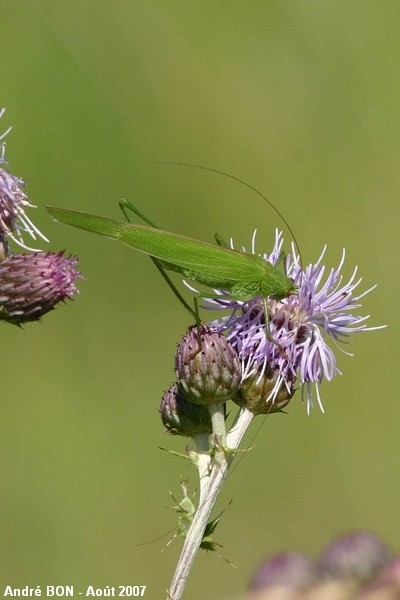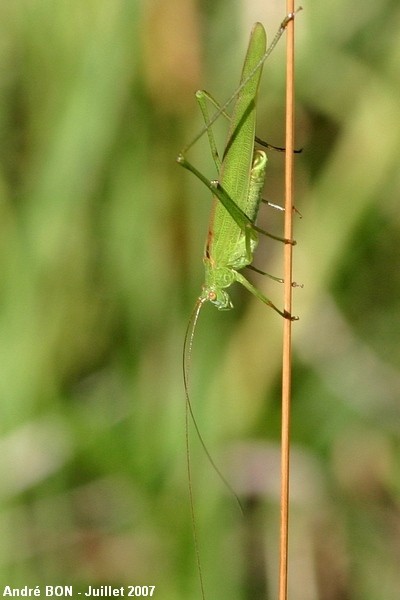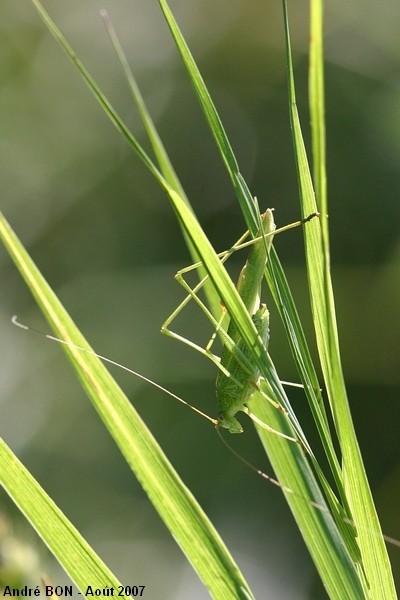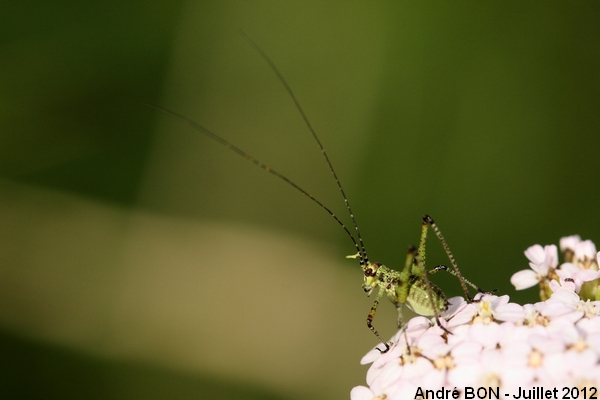



| Sickle-bearing Bush-cricket (Phaneroptera falcata (Poda, 1761)) |




|
|
Scientific name: Phaneroptera falcata (Poda, 1761) Common name: Sickle-bearing Bush-cricket French name: Phanéroptère commun, Phanéroptère porte-faux, Sauterelle à ailes en faux Order: Orthoptera Family: Phaneropteridae Wingspan : 12-18 mm. Biotope: Preference for dry locations: calcareous meadows, fallow lands, bushes, moor lands, road sides. Geographic area: Middle Europe, missing in the southern peninsula. Its range reaches Belgium and the Netherlands northwards and as far as Japan eastwards, including all central Asia. Observation period : July to October. |
The Sickle-bearing Bush-cricket is a medium size grasshopper with a pale green body covered with black spots. It can be identified by its wings which are much longer than the elytra. The pronotum side plates are rounded. The length of the antenna can reach four times the length of the body. The female's abdomen ends with a sharply upturned ovipositor with a slightly wavy baseline. The male's sub-genital plate ends with two short diverging points. The Sickle-bearing Bush-cricket mainly feeds on plants. Females lay the eggs on shrub's leaves, particularly on Blackthorn. The Sickle-bearing Bush-cricket can fly a relatively long distance when frightened. It is difficult to differentiate from the Common Green Bush-Cricket or Mediterranean Katydid (Phaneroptera nana), present in the Mediterranean Basin and whose range is extending northwards. The clues which can help to tell apart both species are: - The Mediterranean Katydid has thicker thighs. - The female Mediterranean Katydid's ovipositor shows a continuous curve with a regular baseline, the female Sickle-bearing Bush-cricket's ovipositor shows a sharp right angle turn with a slightly wavy baseline. - The male Mediterranean Katydid's sub-genital plate ends with two short straight points. They are diverging on male Sickle-bearing Bush-cricket. - On a side view, the Sickle-bearing Bush-cricket pronotum's width is longer than its height, the Mediterranean Katydid's pronotum is higher with a shorter width. |
| [To know more about the Sickle-bearing Bush-cricket ] [Next picture] [Top] |

|
These Grasshoppers have very long antennae. The identification of the Sickle-bearing Bush-cricket is essentially based here on the shape of the pronotum and on the thin hind thigs (viewed on another picture as it seems to me that this one is missing one leg on this side). |
| [To know more about the Sickle-bearing Bush-cricket ] [Next picture] [Previous picture] [Top] |

|
I have been able to get very close to Sickle-bearing Bush-crickets but I have never seen them fly away. |
| [To know more about the Sickle-bearing Bush-cricket ] [Next picture] [Previous picture] [Top] |

|
In July or August, you just need to look down among the high grasses. A complete world is living in here. |
| [To know more about the Sickle-bearing Bush-cricket ] [Previous picture] [Top] |

|
Juvenile on an umbellifer flower. |